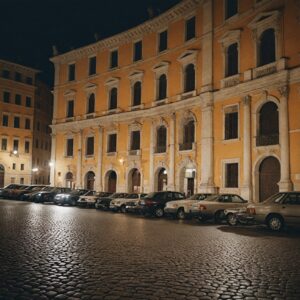Highlights:
– Controversial Viral Post: Former President Donald Trump's AI-generated image as the pope sparked a polarized response, ranging from amusement to criticism, showcasing the power of digital content in stirring public reactions and debates.
– Ethical Debate and Social Media Challenges: The incident ignited discussions on the ethical considerations of AI-generated political imagery, especially concerning religious symbols, and underscored the difficulties faced by social platforms in regulating such content, emphasizing the evolving landscape of online discourse and moderation.
– Intersection of Politics, Technology, and Religion: Trump's "Pope Trump" image epitomizes the complex interplay between politics, technological advancements, and religious sensitivities, shedding light on the profound societal questions surrounding AI's role in shaping political narratives and cultural respect for traditions.

Summary
In May 2025, former U.S. President Donald Trump posted an AI-generated image of himself dressed as the pope on his social media platform, Truth Social, shortly after the death of Pope Francis and during the Vatican’s conclave to elect the new pontiff. The image depicted Trump wearing traditional papal vestments, including a white cassock and a mitre, and was subsequently shared by official White House social media accounts on platforms such as X (formerly Twitter) and Instagram. The post quickly went viral, eliciting a polarized response that ranged from amusement and support among Trump’s followers to widespread criticism from Catholic leaders, political commentators, and international media.
The New York State Catholic Conference condemned the image as disrespectful and ill-timed, emphasizing the solemnity of the papal election process and the recent passing of Pope Francis. Critics argued that the image trivialized religious symbols and reflected a lack of decorum, with some political figures labeling the post as “unserious” and inappropriate for a former president. Conversely, some conservatives and supporters treated the image humorously, contributing to a broader trend of using AI-generated content for political satire and digital engagement.
The incident sparked extensive debate about the ethical implications of AI-generated political imagery, particularly concerning respect for religious iconography and the boundaries of satire on social media. It also highlighted the challenges social media platforms face in moderating AI-driven content that blends humor, provocation, and political messaging, raising questions about how such material influences public discourse.
Overall, Trump’s posting of the AI-generated “Pope Trump” photo became a notable moment in the intersection of politics, technology, and religion, reflecting broader cultural and societal tensions about the use of artificial intelligence in shaping political narratives and the respect owed to religious traditions.
Background
The AI-generated image of former U.S. President Donald Trump dressed as the pope was posted on May 2, 2025, amid the global Catholic community’s mourning following the death of Pope Francis on April 21, 2025. In the image, Trump is depicted wearing traditional papal attire, including a white cassock and a pointed mitre, commonly associated with bishops, along with a large cross hanging around his neck and a raised finger in a solemn pose. The image was first shared by Trump on his social media platform, Truth Social, without any accompanying comment or context. Shortly after, the official White House social media accounts reposted the image on platforms such as X (formerly Twitter) and Instagram.
Trump’s posting of the image followed his earlier public remarks joking about wanting to become pope, which added a layer of personal context to the AI-generated photo. The image quickly became viral and sparked a wide range of reactions, from humorous and enthusiastic responses among supporters to criticism and offense expressed by members of the Catholic community and political commentators. The New York State Catholic Conference publicly condemned the image, emphasizing the solemnity of the ongoing papal conclave to elect Pope Francis’s successor and describing the image as neither clever nor funny. Critics, including political figures like Michael Steele, labeled the post as “unserious and incapable,” highlighting concerns about decorum and respect for religious symbols.
The image also attracted international attention, particularly in Italy, where media outlets noted the unusual and provocative nature of the AI-generated portrayal. This event forms part of a broader trend of political figures and supporters using AI-generated images and memes for digital engagement, often blending humor with political commentary. While such uses of generative AI tools reflect evolving modes of communication and marketing in politics, they also raise questions about respect for religious symbolism and the impact of AI on public discourse.
The AI-Generated Photo
On May 3, 2025, former U.S. President Donald Trump posted an AI-generated image of himself dressed as the Pope on his Truth Social platform, sparking widespread attention and debate online. The image appeared without any accompanying comment or context and was subsequently shared by the White House on its official X (formerly Twitter) and Instagram accounts. This post coincided with the Vatican’s conclave to select a new pope, adding further significance to the timing of the image’s release.
The origins of the AI-generated photo remain unclear, with no definitive source identified. The portrayal of Trump as the leader of the Catholic Church elicited a polarized response from the public. Many of Trump’s supporters shared the image with enthusiasm, often adding laughing emojis or captions such as “Pope Donald I,” while critics viewed it as an example of Trump’s perceived disregard for decorum and respect for religious symbols. The image also caught the attention of international media, notably in Italy, where it was widely discussed.
The “Pope Trump” image is part of a broader trend involving politicians leveraging generative AI tools for creating memes, marketing content, or digital engagement. Satirical artists quickly joined the phenomenon by producing their own AI-generated depictions of political figures as religious icons, superheroes, or even extraterrestrials. For instance, a popular post on X showed President Joe Biden as a Buddhist monk with the caption “Your move Joe,” illustrating the wider cultural impact of AI in political satire and online discourse.
The incident has reignited discussions about the ethical implications of AI-generated content, particularly regarding respect for religious imagery and the boundaries of political satire on social media platforms. Whether platforms like Truth Social will implement measures to regulate such content remains uncertain.
Dissemination
The AI-generated image of Donald Trump dressed as the pope was initially posted on his official Truth Social account without any accompanying commentary or context shortly before Catholic cardinals began a conclave to elect the next pope. Following its appearance on Truth Social, the image was also shared by the White House’s official accounts on X and Instagram, further amplifying its reach.
The source of the image was not immediately clear, and Trump himself did not provide an explanation or statement alongside the post. The image quickly became a focal point of widespread social media attention and sparked a polarized response. While some users defended it as a joke, others strongly criticized it for its perceived disrespect toward religious symbols and the solemnity of the papal election process.
The New York State Catholic Conference, representing the state’s bishops, publicly condemned the image on their official X account, emphasizing that there was “nothing clever or funny about this image.” They noted the timing was particularly insensitive given the recent burial of Pope Francis and the commencement of the conclave to select his successor. This condemnation was amplified by the fact that the image had been reposted by the White House’s official channels, provoking further backlash and debate about the appropriateness of the dissemination.
Whether other platforms similar to Truth Social would implement measures to moderate or restrict such content remains uncertain, highlighting broader societal and ethical questions about the influence of AI-generated imagery in public discourse.
Public and Media Reaction
The AI-generated image posted by Donald Trump elicited a wide range of reactions across social media and various communities. Some users defended the image as a joke and shared it with humorous or enthusiastic captions such as “Pope Donald I,” while others strongly criticized it as disrespectful and offensive. The post sparked particular outrage among Catholic leaders and organizations, who viewed it as a mockery of their faith and religious symbols during a solemn time following the death of Pope Francis.
The New York State Catholic Conference condemned the image in a statement on X (formerly Twitter), stating, “There is nothing clever or funny about this image, Mr. President. We just buried our beloved Pope Francis and the cardinals are about to enter a solemn conclave to elect a new successor of St.”. Similar criticism came from a spokesperson for the Catholic Diocese of New York, who remarked that while satire is often used in politics, comparing oneself to the pope—even in jest—crosses a line for many faithful Catholics. The image was also criticized by former Italian Prime Minister Matteo Renzi, who described it as offensive to believers and institutions and accused Trump of “clowning around”.
Some Republicans and conservative commentators, including Senator Lindsey Graham, responded with lighthearted or supportive comments. Graham jokingly expressed excitement on X about Trump’s openness to the idea of becoming the next pope. Satirical artists and users further contributed to the trend of portraying political figures as religious or fantastical characters, with one notable post showing President Joe Biden as a Buddhist monk with the caption “Your move Joe”.
The Vatican, while declining to comment directly on the image, noted the sensitivity surrounding the ongoing papal conclave and the mourning period. Cardinal Timothy Dolan, Archbishop of New York and a member of a presidential commission on religious liberty appointed by Trump, was questioned about the image but did not provide a definitive stance. The broader media commentary highlighted that the image touches on deeper societal issues regarding respect for religious symbols, the role of AI-generated content in public discourse, and the boundaries of political satire.
Despite the backlash, the White House dismissed the criticism. Press Secretary Karoline Leavitt emphasized Trump’s respect for Pope Francis and his commitment to religious liberty, noting his attendance at the pope’s funeral in Italy. The incident also formed part of a larger pattern of political figures utilizing generative AI tools for memes and digital engagement, raising questions about the evolving impact of such technologies in politics and culture.
Ethical and Societal Implications
The sharing of an AI-generated image of former President Donald Trump dressed as the pope on his Truth Social platform has sparked significant ethical and societal debate. While some supporters treated the image as a humorous or satirical gesture, others viewed it as a disrespectful act that undermines the solemnity and reverence traditionally accorded to religious figures and symbols.
Religious communities, particularly the Catholic Church, expressed strong condemnation of the image. The New York State Catholic Conference described the image as lacking any cleverness or humor, emphasizing the recent passing of Pope Francis and the ongoing papal conclave to elect his successor, thereby highlighting the timing’s insensitivity. Cardinal Timothy Dolan of New York characterized the post as “not good” and “sad both for the White House and for the president,” suggesting that such representations could diminish the dignity of the office of the papacy and those who respect it. However, he refrained from calling for an official apology.
The incident underscores broader societal concerns about the evolving role of artificial intelligence in political expression and public discourse. The use of generative AI to create and disseminate politically charged imagery raises questions about the boundaries of satire, respect for religious and cultural symbols, and the potential for such content to inflame tensions or offend particular communities. It also reflects a growing trend where politicians and public figures employ AI-generated content as a tool for digital engagement, meme creation, and political commentary, blurring lines between humor, marketing, and provocation.
Critics, including some political commentators, labeled the image as “unserious” and indicative of a disregard for decorum, suggesting that such posts may harm public perceptions of leadership and political discourse. The incident invites reflection on how digital platforms and political figures might navigate the ethical implications of AI-generated content, especially when it intersects with sensitive religious or cultural matters.
Aftermath and Broader Discussions
The AI-generated image of former U.S. President Donald Trump dressed as the Pope, which he shared on his Truth Social platform in May 2025, sparked a wide range of reactions and debates online. Many of Trump’s supporters embraced the image with humor and enthusiasm, often reposting it accompanied by laughing emojis or playful captions such as “Pope Donald I”. Conversely, critics condemned the image as an example of Trump’s alleged disregard for decorum and respect for religious symbols.
The image also attracted significant attention from international media, particularly in Italy, where some outlets criticized the post as being in poor taste, especially since it coincided with a period of official mourning within the Vatican. Italian and Spanish news sources expressed offense at the image, given the solemn context of the ongoing papal conclave. The use of religious attire, notably the white cassock and pointed miter associated with the papacy, was seen as provocative by some observers.
Beyond the immediate reactions, Trump’s AI-generated papal photo became part of a larger cultural phenomenon in which politicians and public figures are depicted through AI tools in various satirical or imaginative guises. For instance, satirical posts also emerged portraying President Joe Biden as a Buddhist monk, reflecting a broader trend of digital engagement and political satire facilitated by generative AI technologies. This trend raises complex questions about the boundaries of online content, the role of AI in political discourse, and the respect owed to religious and cultural symbols.
Amid these discussions, some commentators highlighted the potential implications for social media platforms, including whether sites like Truth Social would implement content moderation policies addressing AI-generated images and their possible societal impacts. While the post may have been intended as lighthearted or provocative humor, it underscores ongoing debates about the evolving influence of artificial intelligence on public conversation and the ethical considerations it entails.
The content is provided by Harper Eastwood, Front Signals

















